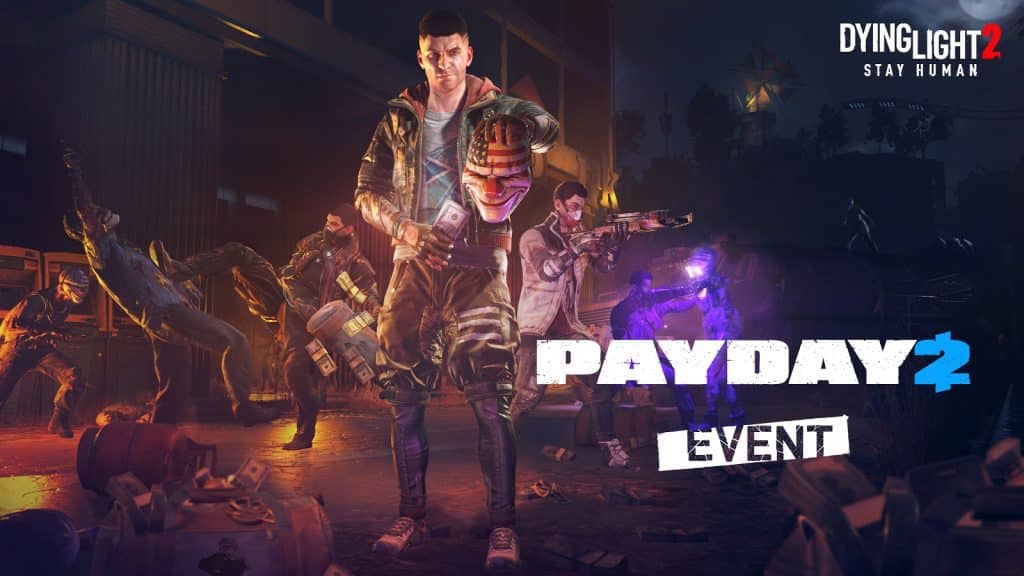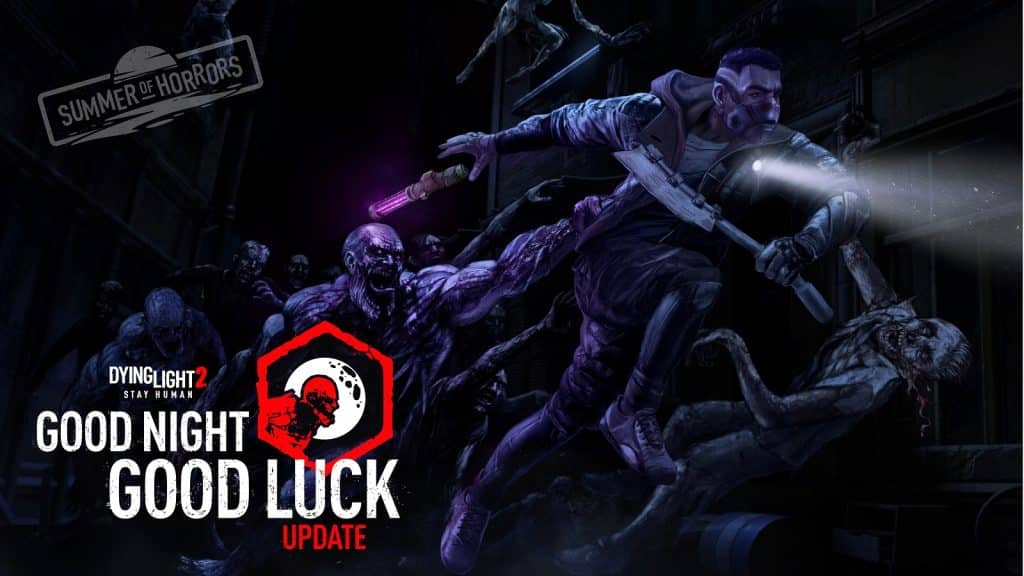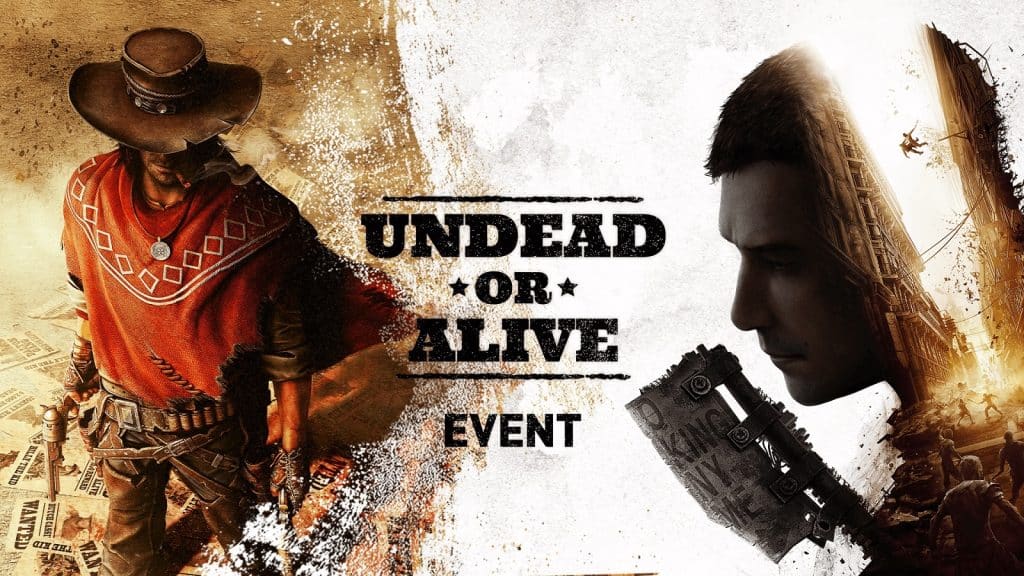Dying Light 2 is an ambitious game with a giant world full of things to explore, people to get to know, and zombie heads to smash. Over the course of my 34 plus hour adventure, I met characters I cared deeply about in the City, the game’s massive open-world set in Europe.
Dying Light 2 does a great job creating a mostly realized world even if some of the buildings and NPCs start to blur together due to a lack of variety. By the end of the game, I had forged connections with my favorite characters and found myself getting emotional in the game’s finale.
The game takes place fifteen years after the Harran virus spread to the rest of the world. Humanity clings to life in the few remaining settlements scattered across the world, and these communities stay connected thanks to Pilgrims. These are badass mercenaries who travel hundreds of miles between settlements to bring survivors information and resources. You control Aiden Caldwell who works as a Pilgrim and ends up in the City looking for his sister, Mia.
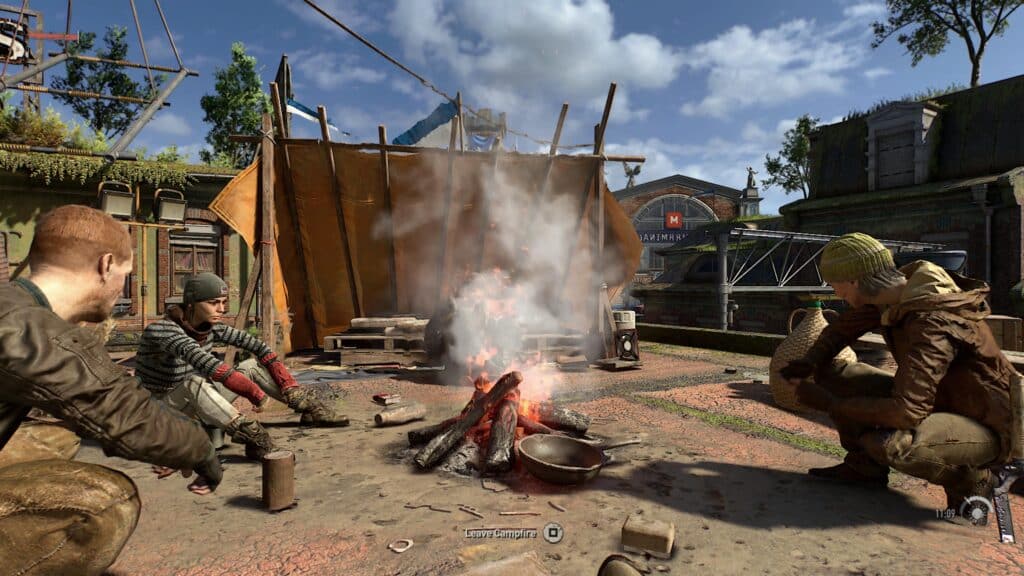
Aiden is a fairly neutral protagonist, and Jonah Scott’s performance helps make him likable, compassionate, and occasionally even funny. He’s definitely a sort of everyman.
Thanks to the number of choices in the game, he can bend to how you want to play. If you want to be a ruthless asshole, there are dialogue choices that will let you. Of course, there’s the opposite too, should you want to help others. Certain choices in the game are huge in scope and have clear repercussions based on what you choose. There are moments where I found myself pausing as the timer counted down and really had to think about who would be affected by the decisions I was going to make. I appreciated how impactful some of these major moments were.
As you move through the game, you’ll meet a variety of people trying to survive from various factions. Each faction feels distinct and developed. There are the Survivors, regular people just trying to get by; the Peacekeepers, a militaristic group trying to provide order to the land; and the Renegades, former prisoners and scroungers creating havoc. While a lot of the voice performances across the groups are good, there were some inconsistencies.
While subtle, it sounded like one of the first major Survivor characters you meet sounds fairly neutral in their tone, but then I thought I detected a slight British accent. Their voice would swing between the two. It was so noticeable that my partner even noticed and commented.
The Renegade faction, a group of bad guys who torment survivors and Aiden, all sound like Batman villains. The performances aren’t bad, but they are jarringly cartoonish when compared to how grounded most of the other performances are. Also jarring were NPC models being overused. I met characters with the same face several times. The only major difference was a change in hair color and style. Two of those were twins, but later on, I met a third and fourth. And this left me very confused.
Rosario Dawson lends her voice and likeness in a fantastic performance as Lawan, a tough as nails, cross-bow-wielding woman searching for revenge against those who wronged her. She helps ground Aiden, at least in my playthrough. It’s clear through dialogue decisions that she could either be lenient with her enemies, as I convinced her, or she could become consumed by her revenge.
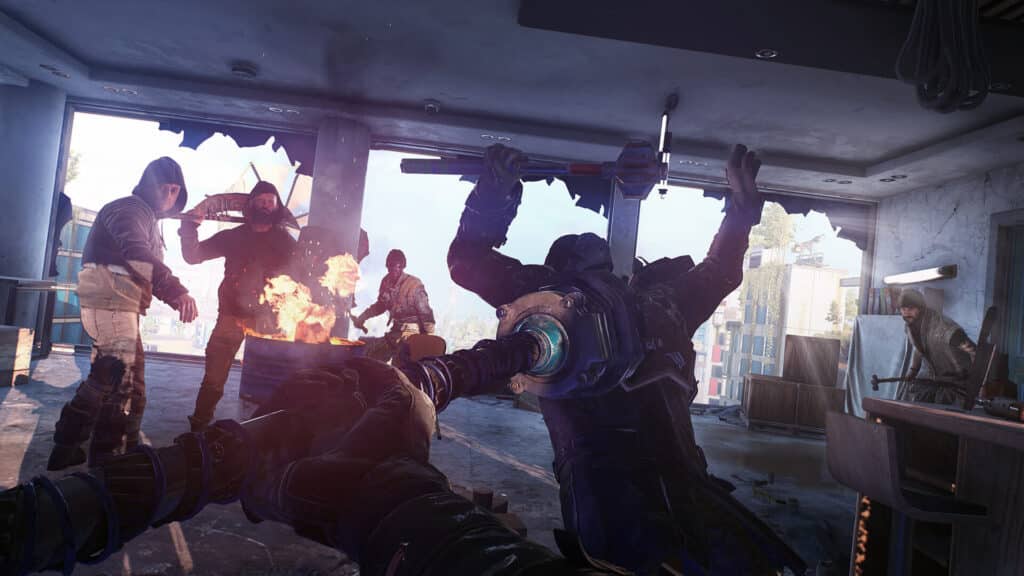
Overall, the story is engaging, but the main quest line can get bogged down. While everything makes sense in the scheme of the larger story, the central plot takes a long time to pick up steam. It really does in the last few hours of the game as major decisions are made that shape the world. It’s here I found myself engrossed and marathoned until I finished and witnessed the game’s emotional conclusion.
It’s also easy to get sucked into side-quests. From helping reunite a mother with her missing children to helping extract blood from a specific monster for a zany artist to use, there are both touching and humorous stories to discover. With how massive the game is and with how many things there are to do, I could easily rack up one hundred hours just exploring and helping to shape the world as I see fit.
The world itself is mostly shaped by siding with either the Peacekeeper or the Survivors at key moments throughout the game. You’ll have the option to give control of water towers and other resources to one of the groups. The Peacekeepers will install combat-based mechanisms like fire traps to use in fighting the Infected while the Survivors implement items to assist with parkouring like airbags you can jump on to reach greater heights. It’s an engaging way to not only side with the group you prefer but also shape the world to your playstyle.
Just be careful because at certain moments when you pick sides you will make enemies.
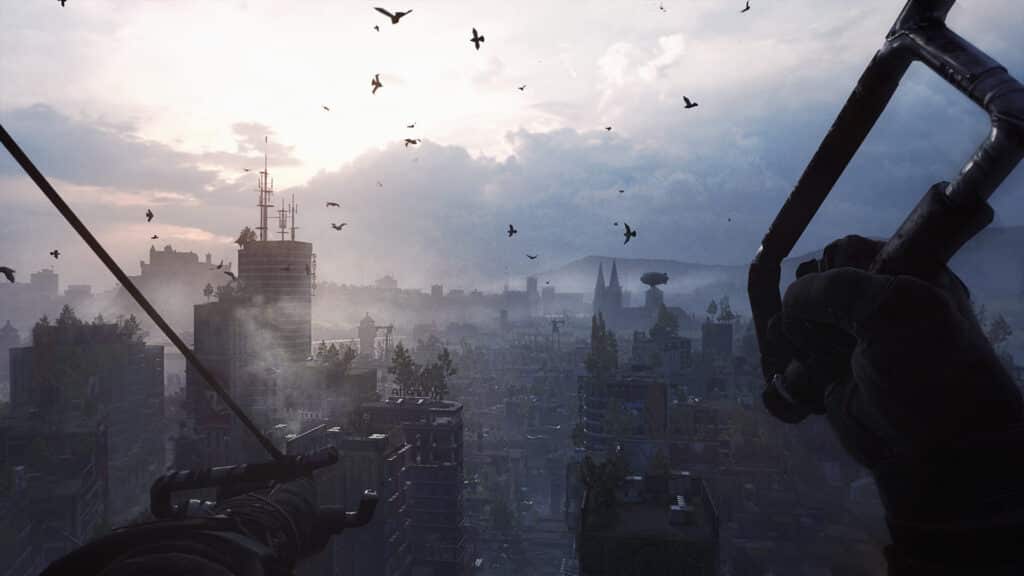
The first moment climbing to the top of a building and looking out over the City is truly mesmerizing. The game looks fantastic. There are points of interest that can be marked on your map using your binoculars. Renegade camps built onto skyscrapers, supply caches lost on tops of buildings to scavenge, and Windmills to power up to create safe zones from the monsters at night. It’s one of those games where, if you can see it, you can likely go to it.
The game has three different graphic modes: Performance, Quality, and Resolution. I tested out all three but with how fast the game is, I stuck with Performance mode thanks to its high frame rate that helped keep the action fluid. While Quality, with a focus on Ray Tracing and graphics, looks stunning, the frame rate was noticeably slower. The same went for Resolution which prioritizes 4K.
When you’re moving around the City, things look slightly less exciting. Thankfully textures are crisp, but there are a lot of environments and building types repeated. Also, besides a few landmark places, no one area of the City stands out much from the other.
The landmark places, though, really stand out. There is a gigantic Cathedral that acted as housing for the sick that you get to explore housing hordes of Infected in green medical wear as well as, in the game’s opening moments, a hillside manor with skeleton party goers who died during their last party on Earth. With the game being as large as it is, I can’t fault it too much, but I did find myself wanting more variety. Despite that, the scale of the city and getting to explore it vertically is really incredible.
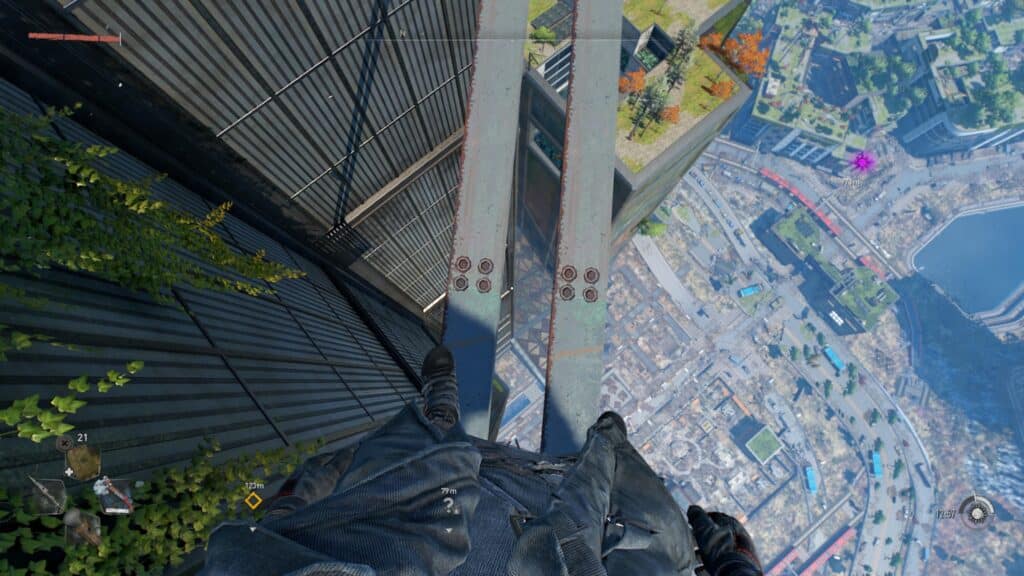
Exploration and parkouring is easily the star of the show. As you level up, you’ll get either Combat or Parkour points to spend in their respective skill trees. Experience is earned through quests and through using combat and parkouring in the city. There are valuable upgrades to make both combat and parkour more dynamic. Parkouring was my preferred way to play.
Aiden is designed to move quickly with his running speed and jumping abilities. Eventually, you unlock a Paraglider and Grappling Hook, which works like a rope you can shoot out to swing from place to place. It’s easier to run, jump, slide and hide than to fight enemies. Occasionally, I had issues with controls when jumping and climbing that caused some major frustration. Especially when trying to climb up a Windmill’s jumping puzzle to establish safe zones. Some of them seemed impossible to finish and I gave up.
Moving through the air on your Paraglider really showcases how much love went into the world. Movement feels natural and it lets you really take in the city. There are some story moments that take you to the tops of skyscrapers after you unlock the Grappling Hook. Swinging precariously on the sides of the building ranks as one of the best moments in the game for me. I found myself leaning with the swing of the rope and gritting my teeth in hopes of making the jumps.
While combat isn’t bad, it’s still somewhat boring. It can be satisfying when fighting hordes of enemies – either the Infected or human variety. Slicing them to pieces in slow motion is very satisfying. As is using a blunt-type weapon to charge up an attack that causes an enemy to soar through the sky off the top of the building. Otherwise, it just doesn’t feel exciting like exploring the world through parkour does.
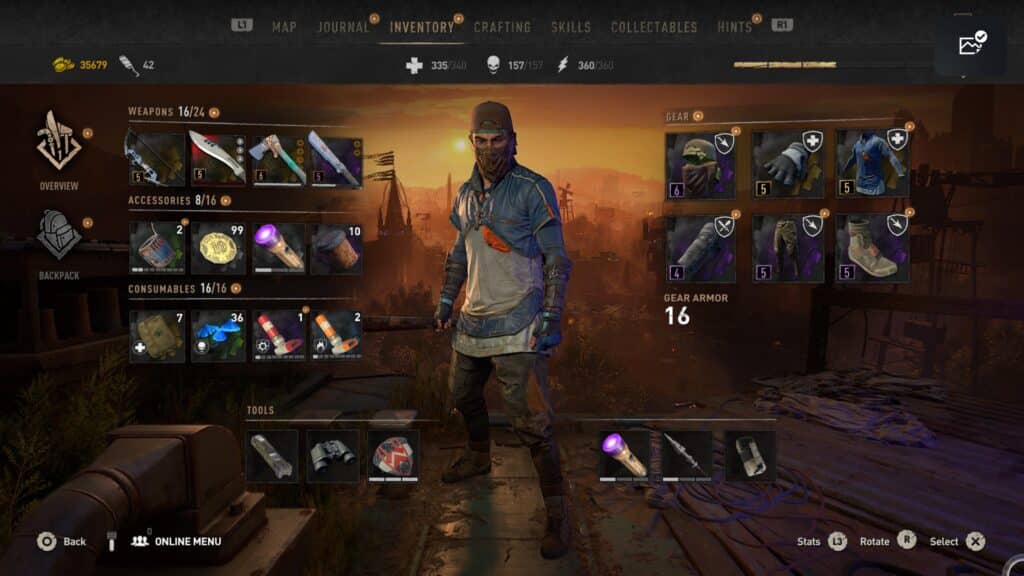
The unlocks for the combat skill tree, however, do not add to the excitement I want in combat like the parkour unlocks did. It also doesn’t help that a lot of the maneuvers available in combat feel clunky to control and execute.
I also thought the gear system felt like an afterthought. While you can upgrade your clothing, it never really felt impactful. Each comes with its own stats based on if you’d rather play more like a Tank, Medic, or Ranger, but even those don’t make the choices feel like you’ve done much. Since the game allows for co-op, it might be more useful there since you could designate roles, but it’s not something I was able to dive into pre-release.
Opposite of that, I enjoyed the weapon variety and scavenging through the world to find materials to craft grenades, Molotov cocktails, and weapon upgrades.
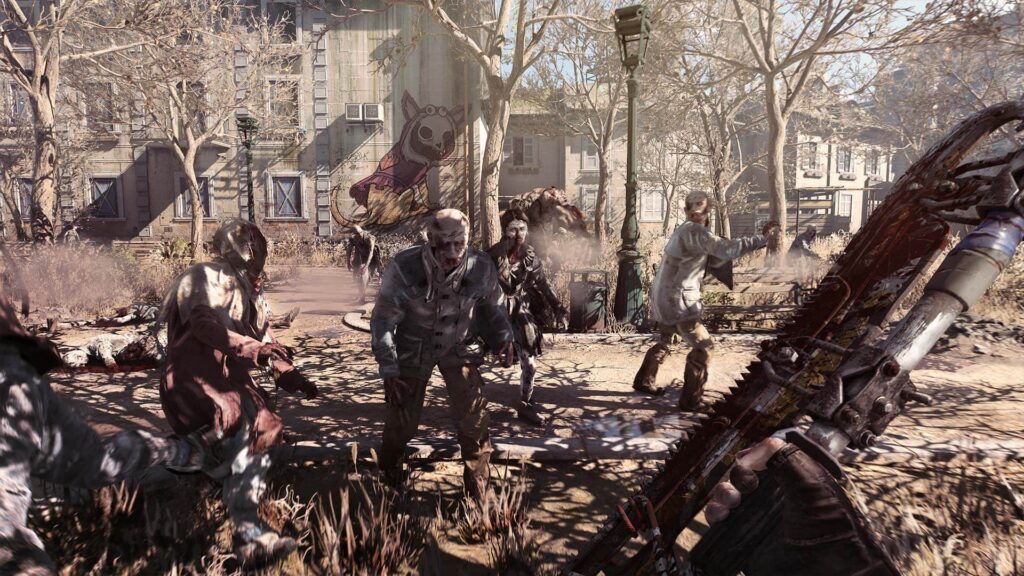
Enemy variety isn’t super expansive but those that are there offer up challenges and a variety of playstyles to take them down. I also appreciated the variety in the Biters, or the most common infected you’ll face. Many of them told stories based on what they wore and where they were found. I was simultaneously disappointed and relieved that the super-powerful Volatiles aren’t found out in the world at night like they are in the first game. They are reserved for more uncommon encounters inside buildings.
Truly terrifying though is the game’s chase mechanic. If you are spotted by a Howler, a new infected type, it lets out an unearthly scream and a chase sequence starts. Enemies will begin running out of doors and from vents to chase you down and kill you. The chase meter rises the further it lasts. The best way to end it is to run to a Safe Zone or, once you unlock it, use an air vent to fly high into the air with the paraglider until the meter runs down.
I’d also be amiss if I didn’t mention the bosses. Dying Light 2 lacks major boss encounters, but with how lackluster the combat could be, I wasn’t necessarily mad. But I thought there might be some cool bosses in specific moments where I’d enter a grand room with weapons and health scattered around only to be disappointed I was facing a group of angry humans or the Infected. The final boss has several phases and they’re all fairly similar. I found myself really wishing that section had been trimmed down. It just kept going.
With how ambitiously large the game is, I did encounter a number of glitches through my playthrough. I had moments where all dialogue and sound effects completely stopped that made me miss key scenes. Only a hard reset fixed that. I also got stuck in walls and once got stuck hanging in the air. I also had the game reset during the final boss and at one point the final boss got stuck in a pipe and I had to reset the game.
Worst of all was when I died during a story mission that had me climbing up a very tall building to a radio tower. At one point I fell and died, and the game respawned me much further than I had been. I missed some specific, important dialogue because of that. Despite the bugs and glitches, nothing was ever game-breaking for me luckily.

Dying Light 2 embraces all of its parts, and while not all of them are as good as they could be, the final product is still a fun run through the City smashing zombie heads. There are characters to love, and the choices you make will ripple throughout the game’s open-world in emotional and unexpected ways. Multiple playthroughs would be required to see everything. It’s easy to get lost in just how expansive it all is.
Dying Light 2: Stay Human largely improves upon the original in every way, and it will have you enveloped in the dying light of the City again and again as you glide, climb, and jump from roof to roof in search of the next thing to explore.





